
Trails and trip ideas
Jasper National Park
On this page
Jasper National Park offers backcountry adventures for everyone, from easy, one-night escapes for the family to advanced multi-week trips deep into Jasper's rugged backcountry. There are options for hikers, paddlers, horse riders and mountain bikers.
For an overview of the park’s backcountry trail options, download our Jasper National Park Backcountry Guide (PDF, 14.9 MB). For in-depth trip planning, our individual Backcountry Trail Guides provide detailed information for each backcountry trail. Before heading out, check out the Backcountry Planning Guide to find out what to expect, what to bring and how to ensure a safe trip.
Once you have planned your adventure, book it online or by calling.
Backcountry trail guides
Two or three day trips
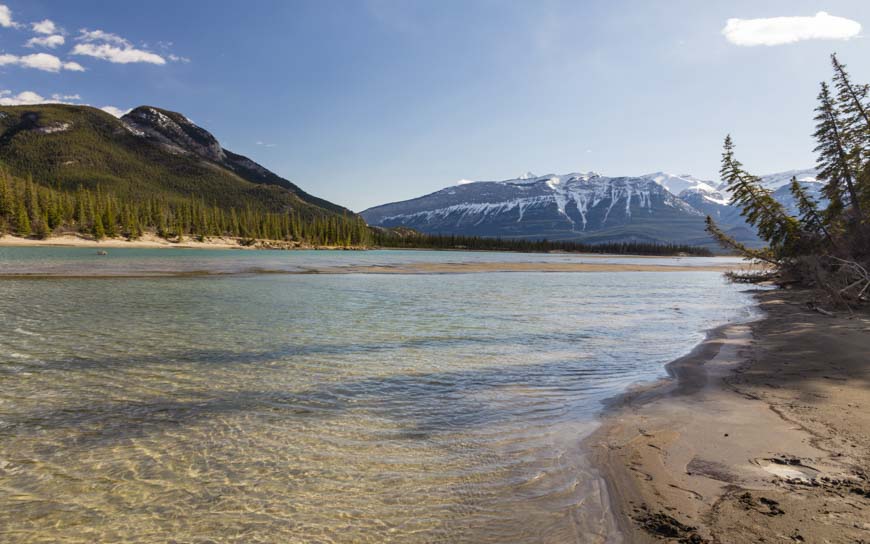
3.5 km paddle from 12 Mile Bridge | 22.3 km paddle from Old Fort Point | 4 km paddle to takeout at Highway 16 on Jasper Lake | Dogs permitted
Getting to Athabasca Island is along a beautiful Grade I stretch of the Athabasca River. Visitors can put-in at 12 Mile Bridge for a short 3.5 km paddle or lengthen their river travel by opting for put-ins at either Old Fort Point or Sixth
Bridge. This trip is not recommended for novice paddlers.
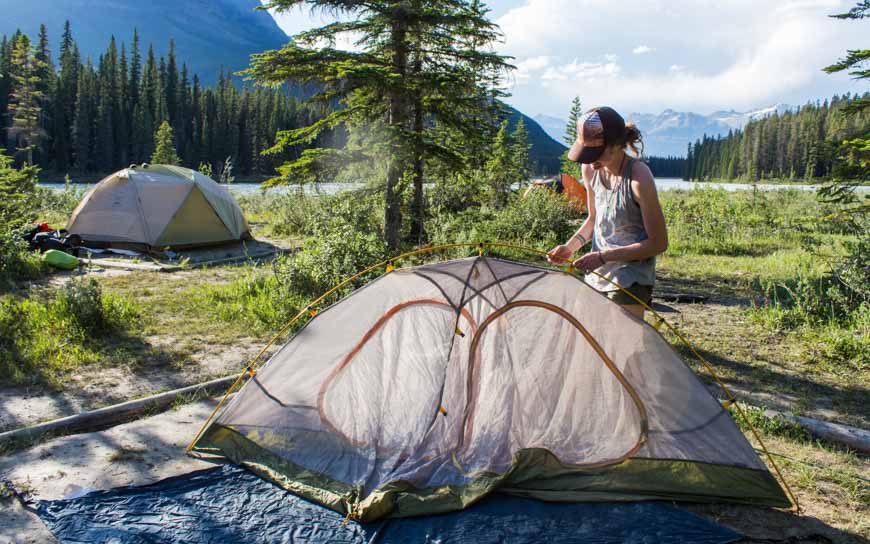
Chaba Trail: Big Bend and Athabasca Crossing
6.3 km to Big Bend | 14.8 km to Athabasca Crossing | 2-3 days return | Dogs permitted | Bikes permitted | Horses permitted
Hike or bike through the forest along this old fire road and emerge at Big Bend Campground for spectacular views of the Athabasca Valley.
Big Bend Campground is a great destination for first time backpackers or families. Stay overnight at the campground, or carry on to Athabasca Crossing campground,
where you can glimpse the upper Athabasca River. This trail is an excellent early or late season choice.
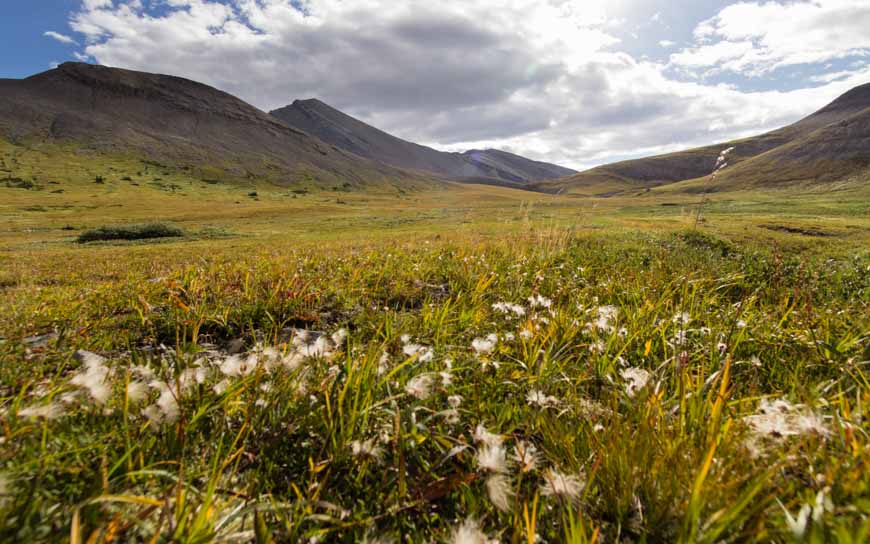
37.8 km one-way | 2-3 days | Dogs permitted | No bikes
This rough trail through a remote valley in the eastern part of the park sees few visitors. Yet it features pleasant riverside views, a stunning alpine pass and, if you plan it right, a soak in the scenic Miette Hot Springs at the end of your hike. This trail can be difficult due to several
unbridged stream and river crossings. The section in Whitehorse Wildland Provincial Park can be extremely muddy and is unsigned for the most part. This trail is best in late August or
September when water levels are lower and the trail is drier.
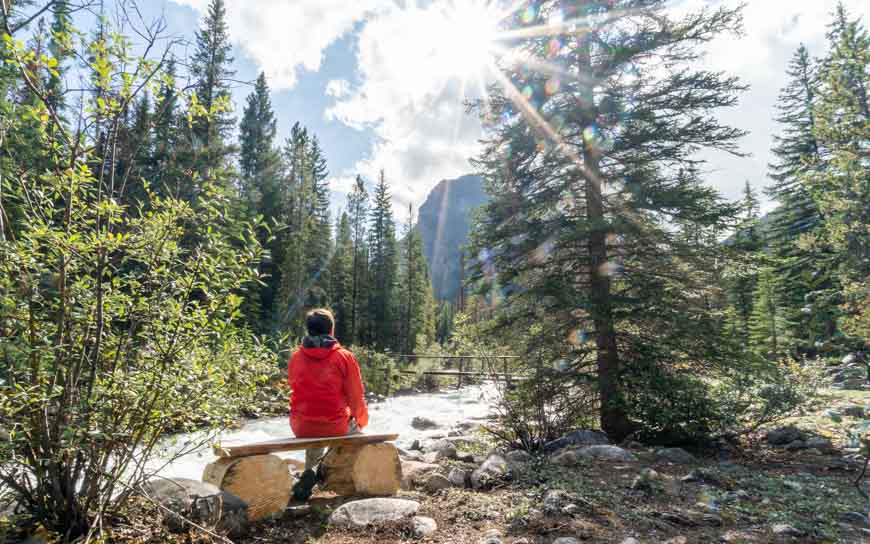
22 km one way | 2-3 days | Bikes permitted to Lower Fryatt campground | Dogs permitted | No horses
Dramatic peaks and a picturesque hanging valley draw backpackers to this trail. The headwall accessing the hanging valley and the ACC hut is a very steep and strenuous ascent.
Two campgrounds and an Alpine Club of Canada hut along the way provide options for itineraries. One popular choice is to make a base camp at Brussels Campground (#35) to explore the upper
valley without a backpack. Lower Fryatt Campground (#34) is a good choice for an early or late season trip and can be travelled by mountain bike.
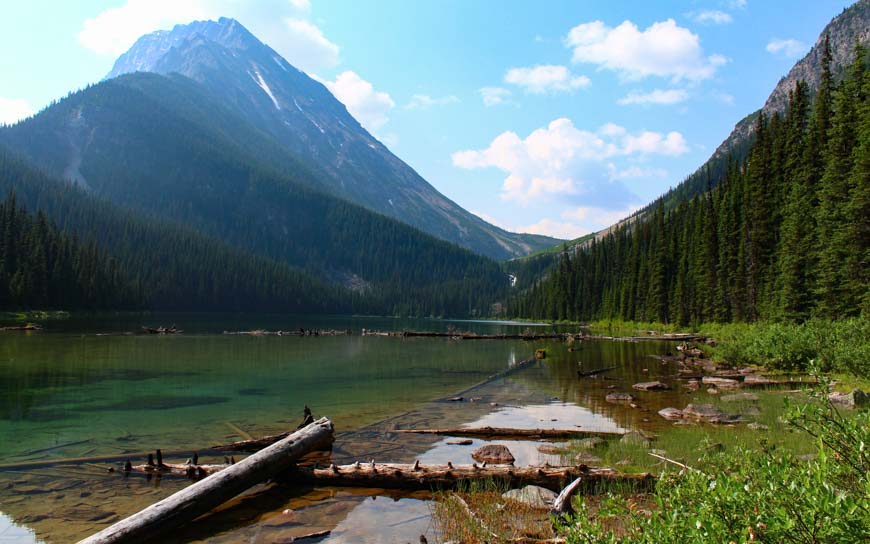
6.2 km one-way | 1-2 days | Dogs permitted | No bikes | No horses
While the trail to the campground is short in distance, the elevation gains, navigation of large boulder fields, and the climb up a steep headwall make it a challenging hike.
Your efforts are rewarded along the way with scenic waterfalls and panoramic views.
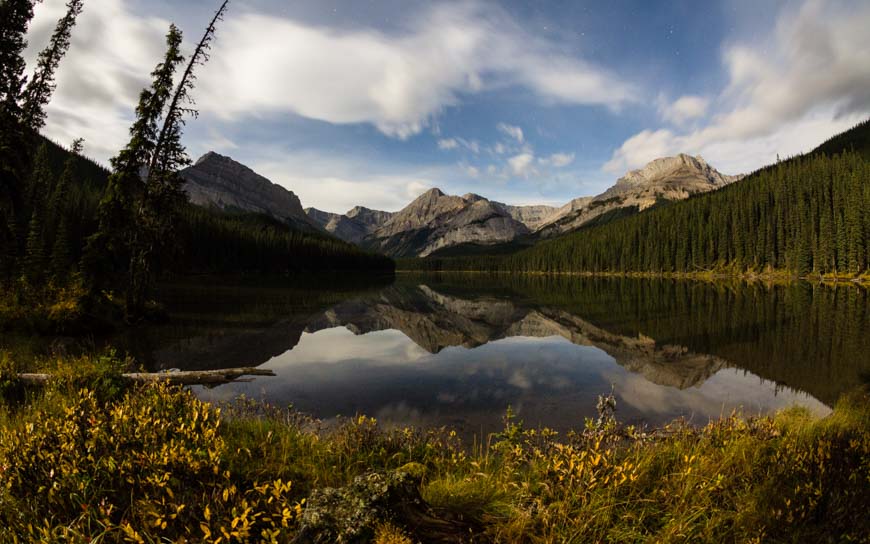
12.2 km one way | 1-2 days | Bikes permitted to Summit Lakes | Horses permitted | Dogs permitted
The Jacques Lake Trail makes for a great one-night backpacking trip and can be travelled in early or late season. Highlights include wilderness lakes, wide-open peak views and straightforward, valley-bottom hiking. Moose
are commonly seen at Jacques Lake. During winter months, an Alpine Club of Canada cabin is available for advance booking.

Jonas Pass - Poboktan Creek Trail
54 km one-way | 3-4 days | No dogs | No horses
This wilderness hike travels through over 13 km of alpine. It features panoramic views and waterfalls. Passes may be snow covered until July; travel is not recommended earlier in the season. Since there
are two trailheads, transportation for the 44 km between is required
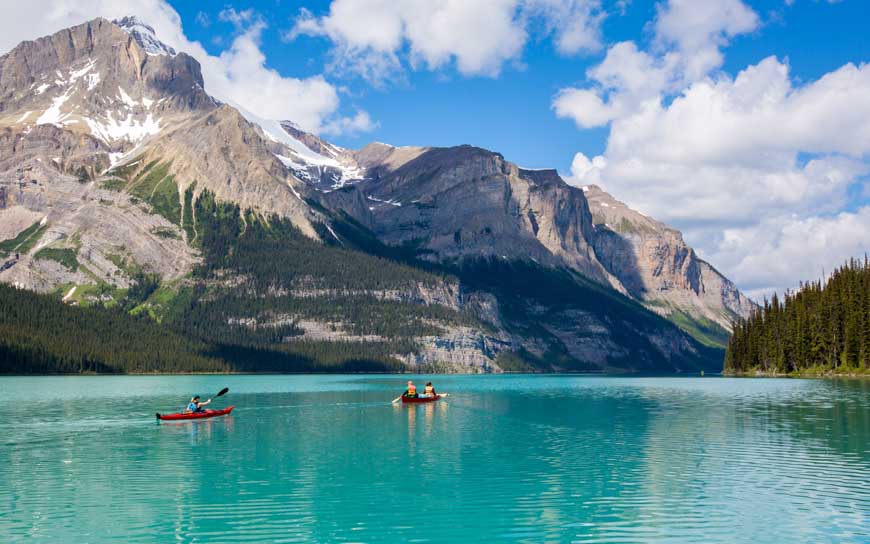
22 km paddle to end of lake - Hidden Cove: 4 km - Fisherman’s Bay: 13 km - Coronet Creek: 21.3 km | Electric boat motors permitted
This glacial-fed lake is famed for its majestic peaks, blue-green water and Spirit Island. There are three popular campgrounds along the lake. High winds are possible and the water very is cold, even in mid-summer.
Maligne Lake is open to paddlers and electric motors only; gas motors are prohibited.
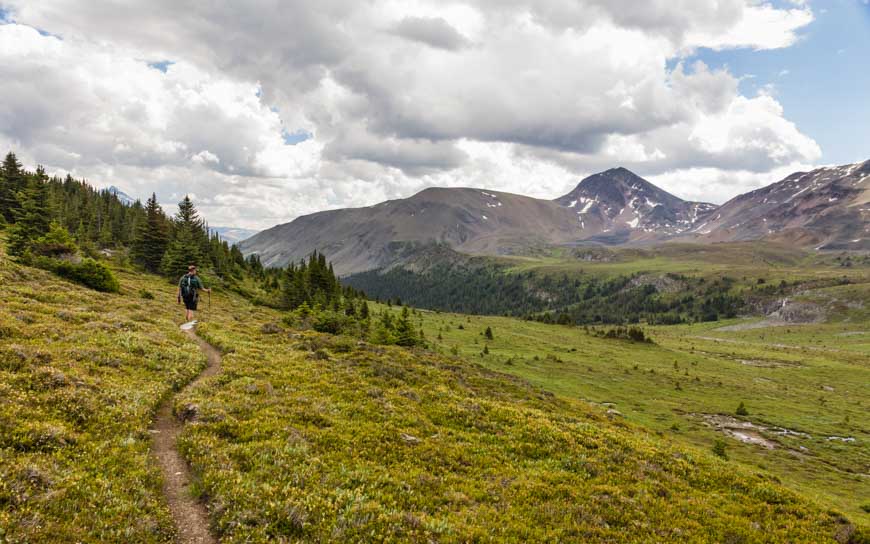
48 km one-way | 2-3 days | No dogs | No bikes | No horses
Maligne Pass is well known for its spectacular wildflowers and incredible alpine meadows. River crossings are necessary and may be challenging during times of high water. The trail can be faint,
boggy and muddy and require route finding. Much of the trail is through forest and willow meadows. Late summer and fall are the best times to hike this trail.
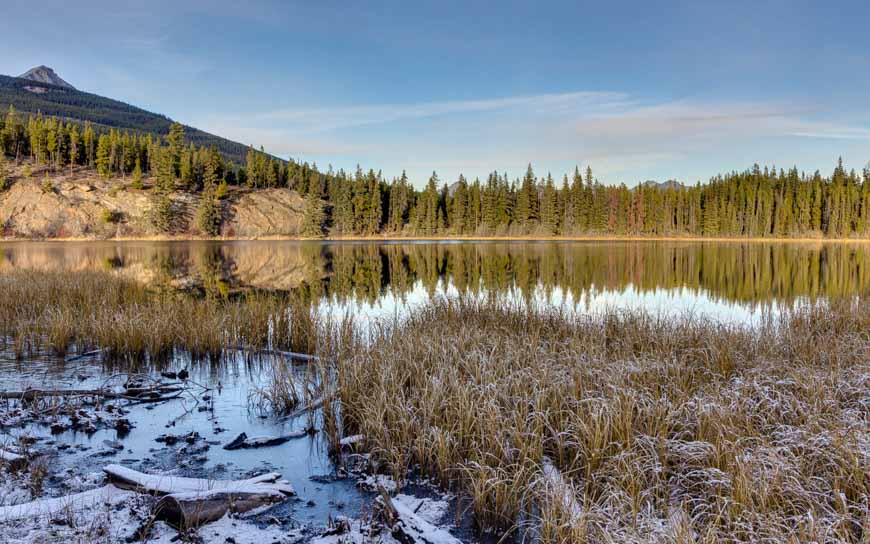
24.6 km loop | 2-3 days | Bikes permitted | Horses permitted | Dogs permitted
Step onto this backcountry trail right from the Town of Jasper. Travel through the hills adjacent to the town, visiting quiet lakes and viewing wildflowers and wildlife. The lower elevations of this trail often mean it can be accessed earlier or later in the season. The loop can be hiked or mountain biked.
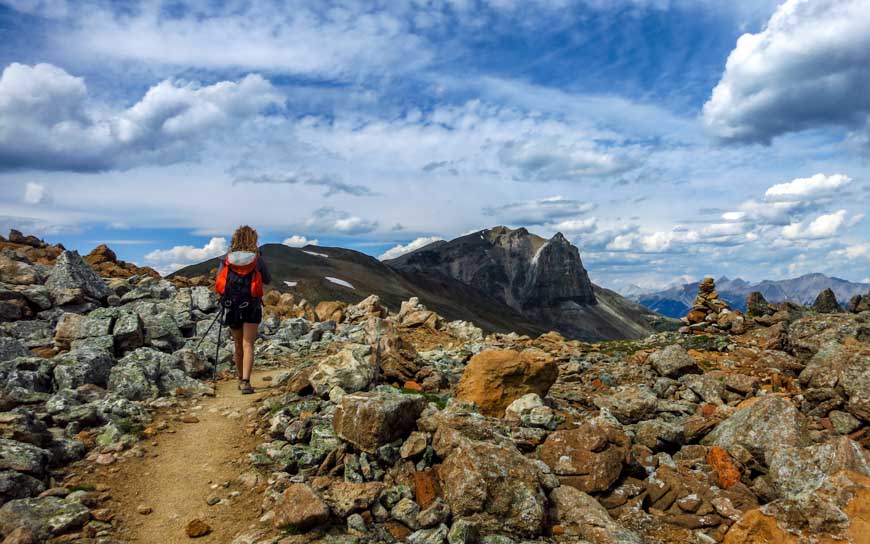
44.1 km one way | 2-3 days | No dogs | No bikes
With almost 25 km of this trail hiked above treeline, the Skyline is Jasper’s highest and possibly most scenic trail. The high elevation allows for amazing views that extend over much of the park, encompassing vast meadows and windswept ridges. Crossing three mountain passes,
the Skyline Trail offers a variety of flora, fauna and scenery unique to Jasper National Park. The section of trail called “The Notch” can be impassable early in the season.
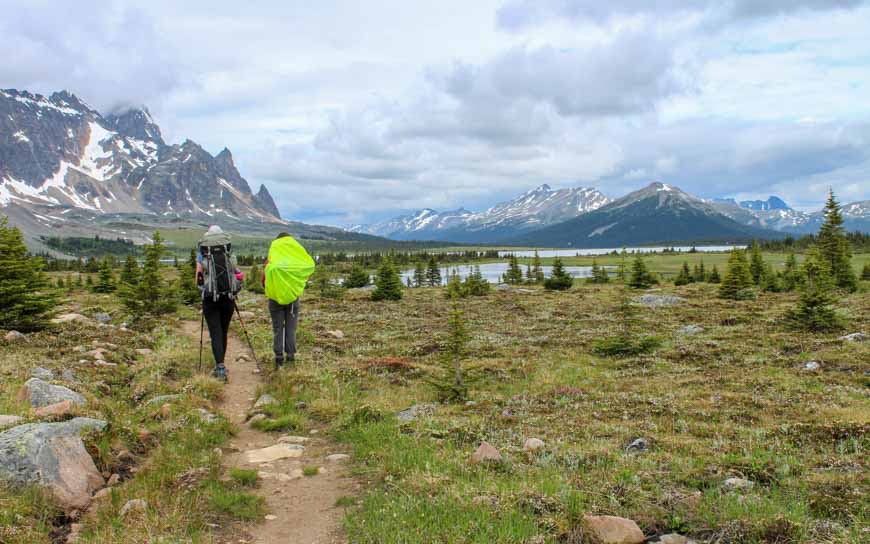
43.1 km one way | 2-3 days | No dogs | No bikes | No fires
The Tonquin Valley is one of Canada’s premiere backcountry destinations, with impressive peaks, glaciers and scenic lakes. It’s also known for its variety of wildlife, which includes grizzly bears, black bears and caribou. The area has a reputation for muddiness and an abundance of mosquitoes. Late summer and fall
are the best times to enjoy this trail. Seven campgrounds, and an Alpine Club of Canada hut can be booked ahead for accommodation.
Four to six day trips
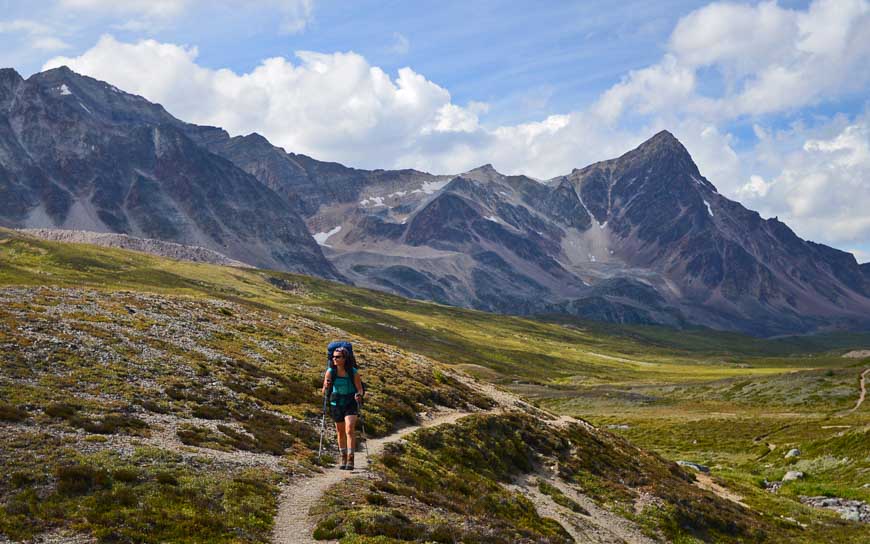
81 km loop | 5 days | No dogs | No bikes | No horses
The Brazeau Loop is a demanding high-elevation trail that crosses three mountain passes. River fords will be necessary. Sudden weather changes are common. Efforts on this longer-distance wilderness hike
come with many rewards. Strong hikers can complete the loop in five days. The passes may be snow covered until July; travel is not recommended earlier in the season.
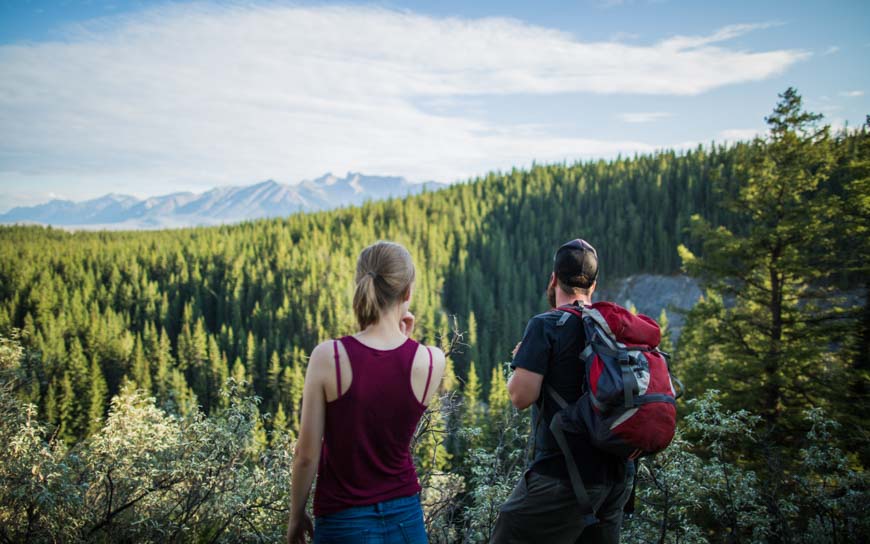
Celestine Lake to Rock Lake Trail
52.8 km one way | 3-4 days | Dogs permitted | Bikes permitted
The trail from the Celestine Lake trailhead to the Rock Lake trailhead follows an old road for the majority of the way. Along the way, you can visit Princess and Celestine Lakes, and Snake Indian falls at km 27 are impressive. Beyond Willow Creek Campground, the trail can be boggy in sections and requires a ford of Rock Creek. The trail can be hiked or biked.
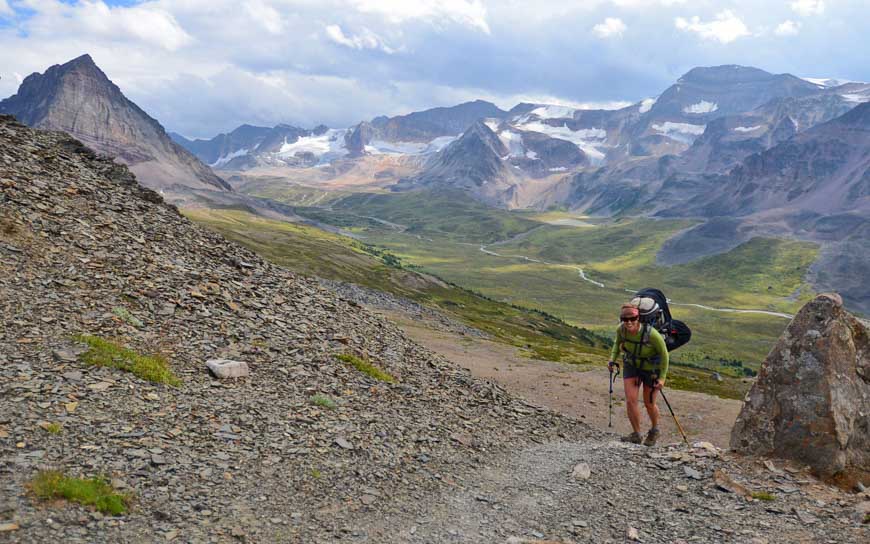
Jonas Pass - Poboktan Creek Trail
54 km one way | 3-4 days | No dogs | No horses
This wilderness hike travels through over 13 km of alpine. It features panoramic views and waterfalls. Passes may be snow covered until July; travel is not recommended earlier in the season. Since there
are two trailheads, transportation for the 44 km between is required.
Seven and longer day trips
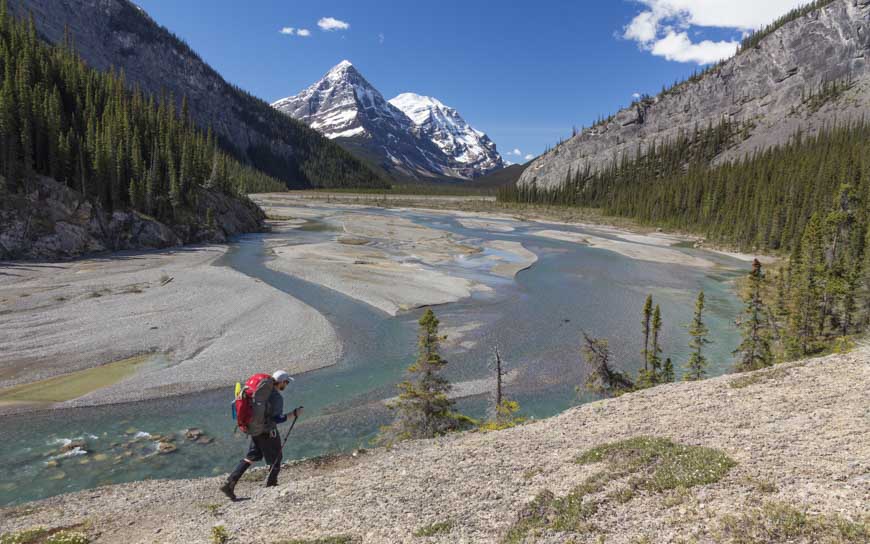
48.5 km one way | 4-5 days | Bikes permitted to Simon Creek | Dogs permitted | Horses permitted
This remote, historic trail follows the Whirlpool River Valley, the traditional route of early fur traders crossing the Rocky Mountains. The trail starts on an old fire road that passes by Whirlpool Campground. This campground overlooks the river and is a great option for families
or beginner backpackers. Beyond Whirlpool, the trail becomes more rugged as it stretches to the remote reaches of the west park boundary. Some rivers and creeks are not bridged. Fords can be dangerous. Rivers can be impassable during times of high water.

Little Heaven - Upper Blue Creek Route
64 km one way | 7-10 days | Dogs permitted | No bikes
This is a remote wilderness route, recommended for users with solid backcountry skills and experience. Highlights include McLaren Pass, Topaz and Caribou Lakes and the broad views of Upper Blue Creek
drainage. The side trip to Azure Lake and Hardscrabble Pass, while overgrown, is impressive. Some major rivers are not bridged. Fords can be dangerous. Rivers can be impassable during times of high water
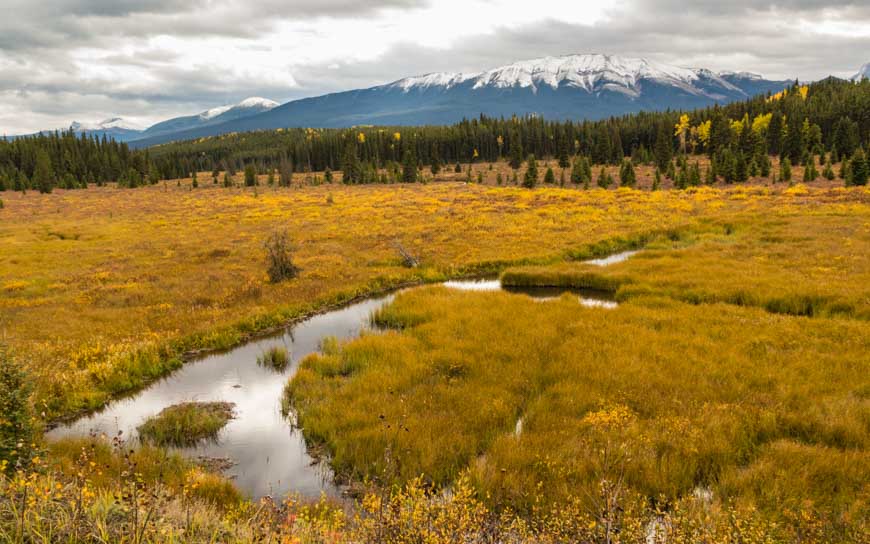
159 km one way | 7-10 days | Dogs permitted | Horses permitted | No bikes
The North Boundary trail is a remote wilderness route, recommended for users with significant backcountry skills and experience. Highlights include Snake Indian Pass and the headwaters of two major park rivers; the Snake Indian River
and the Smoky River. Some major rivers are not bridged. Fords can be dangerous. Rivers can be impassable during times of high water. This trail is best travelled in later season.
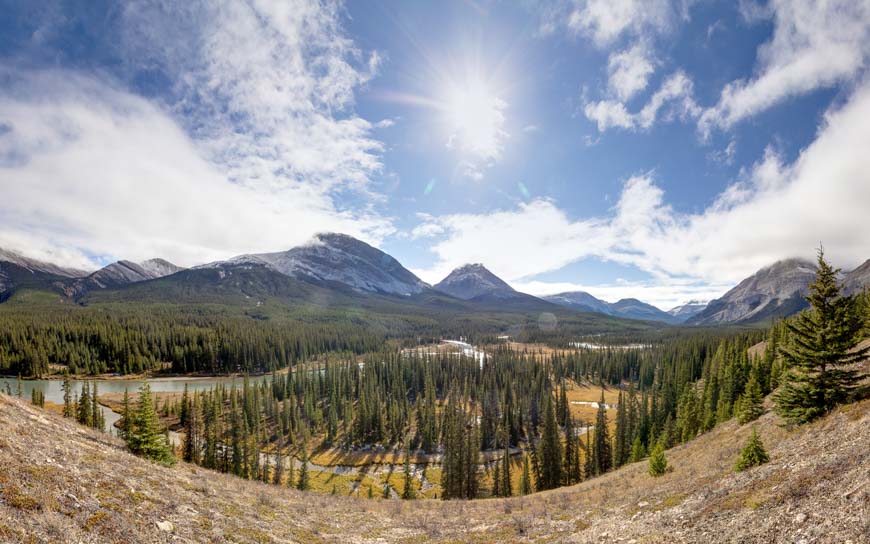
121 km one way | 7-10 days | Dogs permitted | Horses permitted | No bikes
The South Boundary is a remote wilderness route, recommended for users with significant backcountry skills and experience. The trail may be overgrown and difficult to find in places; expect route finding.
Most creeks and rivers are not bridged. Fords can be dangerous. Rivers can be impassable during times of high water. Highlights include the open views of Cairn Pass and Rocky (Cardinal) Pass, glacial fed rivers and solitude.
Helpful information
Backcountry huts and lodges
Backcountry huts and lodges
There is one commercial backcountry lodge along the Skyline trail:
The Alpine Club of Canada (ACC) manages two hike-in huts and two climbing huts:
Hike-in huts:
Climbing huts:
If you are staying at an ACC hut you must acquire a Parks Canada backcountry camping permit.
Mountain biking
Mountain biking
The most popular backcountry trails to access by mountain bike include:
- Fryatt Valley trailhead to Lower Fryatt Campground
- Athabasca Pass trail to Tie Camp Campground
- Saturday Night Lake Loop
- Celestine Lake
- Chaba Trail to Big Bend or Athabasca Crossing.
For a complete list of where bikes are permitted in Jasper National Park, visit Important Bulletins.
Check the mountain biking guide for further information on mountain biking in the park.
Guides and outfitters
Guides and outfitters
Numerous guiding companies are licensed by Parks Canada to offer transportation and guiding services within Jasper National Park.
For the highest standards of local knowledge and safety, look for guides who are accredited by either or both the following professional organizations:
- Interpretive Guides Association
- The Association of Canadian Mountain Guides
- Local guides can also be found at Tourism Jasper's website.
Random camping
Horse user guide
Climbing, mountaineering and glacier travel
Climbing, mountaineering and glacier travel
Highly specialized equipment and knowledge are necessary for safe mountaineering and glacier travel. If you plan to take part in climbing or mountaineering activities, we recommend reading our Mountain Safety pages. You can also discuss your plans with one of Jasper's Public Safety Specialists by calling 780-852-6155.
A number of excellent guide-books are available for reference at information centres or for sale through the Friends of Jasper National Park.
Mountaineering parties can apply to bivouac in non-vegetated areas.
The Alpine Club of Canada of Canada operates four mountaineering huts in Jasper National Park.
- Date modified :